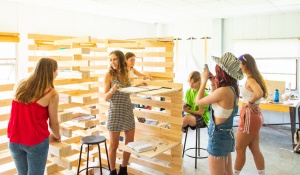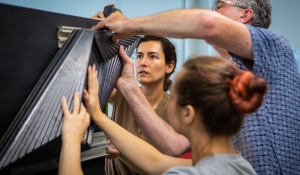Master of Architecture

Material culture research studio, final review, Parker Hall. Photo by Alexander J. Becker
In the face of societal and planetary crises, we’re not just imagining a better world. We’re already building it. Balancing optimism with pragmatism, we teach our students that, as architects, they will play a critical role in the betterment of society and the environment.
Students learn to design informed and innovative buildings and spaces — exploring possibilities that condition how we live, work, and play. Offering the only accredited Master of Architecture program in the State University of New York (SUNY) system, we were recognized in Fall 2024 by the National Architectural Accreditation Board (NAAB) and were among the few programs in the U.S. to meet all accreditation criteria. The visiting accreditation team celebrated the department’s culture of care for students, climate of mutual respect among faculty and staff, and reciprocal commitment to stakeholder partnerships.


Choose your degree path
- 2-Yr Research Track (60 credit hours)
- 2-Yr Synthesis Track (60 credit hours)
- 3-Yr Program (90 credit hours)
Cost of Study
- Domestic: $7,530 - $14,070
- International: $14,070
*per semester tuition rates and does not include fees
Admissions requirements
- Application fee: $75
- No GRE required
Join a tradition of experimentation and activism in architecture at UB, and transform the world around you through design.
- Korydon Smith, professor, architecture
Student Life
See our work
Research and Faculty
Offering the only accredited Master of Architecture in the State University of New York, UB's program has been recognized by the National Architectural Accreditation Board.
This program enables international students to apply for STEM Extension. Graduates can work an additional 24 months beyond the completion of their optional practical training (OPT).
Let us know how we can help
**Ranking is based on 2018-19 annual research expenditures by all public schools of architecture and planning within the American Association of Universities. Among the 65 universities within the AAU, there are 34 public universities, 18 of which house accredited architecture and planning programs within one school. Among this peer set are the Harvard GSD, Columbia University, Cornell University, The Ohio State University, and University of Michigan.



